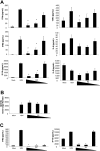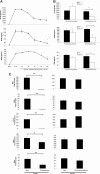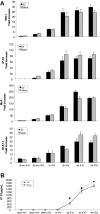Estrogen inhibits dendritic cell maturation to RNA viruses
- PMID: 18802009
- PMCID: PMC2597128
- DOI: 10.1182/blood-2008-04-148692
Estrogen inhibits dendritic cell maturation to RNA viruses
Abstract
Dendritic cells (DCs) play a central role in initiating and polarizing the immune response. Therefore, DC maturation represents a key control point in the shift from innate to adaptive immunity. It is suspected that during pregnancy, hormones are critical factors that modulate changes reported to occur in maternal immunity. Here we examined the effect of 17-beta-estradiol (E2) on the maturational response triggered by virus in human DCs and its influence on their ability to activate naive T cells. We developed an in vitro system to measure the response of DCs to virus infection with Newcastle disease virus (NDV) after a 24-hour E2 treatment. Using this system, we demonstrated that E2 pretreatment down-regulated the antiviral response to RNA viruses in DCs by profoundly suppressing type I interferon (IFN) synthesis and other important inflammatory products. In addition, the DCs capacity to stimulate naive CD4 T cells was also reduced. These results suggest an important role for E2 in suppressing the antiviral response and provide a mechanism for the reduced immunity to virus infection observed during pregnancy.
Figures







Similar articles
-
TLR-independent induction of dendritic cell maturation and adaptive immunity by negative-strand RNA viruses.J Immunol. 2004 Dec 1;173(11):6882-9. doi: 10.4049/jimmunol.173.11.6882. J Immunol. 2004. PMID: 15557183
-
Cell type-specific involvement of RIG-I in antiviral response.Immunity. 2005 Jul;23(1):19-28. doi: 10.1016/j.immuni.2005.04.010. Immunity. 2005. PMID: 16039576
-
Immune responses of mature chicken bone-marrow-derived dendritic cells infected with Newcastle disease virus strains with differing pathogenicity.Arch Virol. 2018 Jun;163(6):1407-1417. doi: 10.1007/s00705-018-3745-6. Epub 2018 Feb 3. Arch Virol. 2018. PMID: 29397456
-
[Immunobiological response against RNA virus infection].Uirusu. 2013;63(2):135-42. doi: 10.2222/jsv.63.135. Uirusu. 2013. PMID: 25366048 Review. Japanese.
-
Recognition of viruses by innate immunity.Immunol Rev. 2007 Dec;220:214-24. doi: 10.1111/j.1600-065X.2007.00562.x. Immunol Rev. 2007. PMID: 17979849 Review.
Cited by
-
Dendritic cells from the human female reproductive tract rapidly capture and respond to HIV.Mucosal Immunol. 2017 Mar;10(2):531-544. doi: 10.1038/mi.2016.72. Epub 2016 Aug 31. Mucosal Immunol. 2017. PMID: 27579858 Free PMC article.
-
Immune cells have sex and so should journal articles.Endocrinology. 2012 Jun;153(6):2544-50. doi: 10.1210/en.2011-2120. Epub 2012 Mar 20. Endocrinology. 2012. PMID: 22434079 Free PMC article. Review.
-
Effect of 17β-Estradiol on Growth and Biosynthesis of Microalgae Scenedesmus quadricauda (CPCC-158) and Duckweed Lemna minor (CPCC-490) Grown in Three Different Media.Plants (Basel). 2022 Jun 24;11(13):1669. doi: 10.3390/plants11131669. Plants (Basel). 2022. PMID: 35807621 Free PMC article.
-
Sex Differences in the Systemic and Local Immune Response of Pancreatic Cancer Patients.Cancers (Basel). 2023 Mar 17;15(6):1815. doi: 10.3390/cancers15061815. Cancers (Basel). 2023. PMID: 36980700 Free PMC article.
-
Effect of Depot Medoxyprogesterone Acetate on Immune Functions and Inflammatory Markers of HIV-Infected Women.J Acquir Immune Defic Syndr. 2016 Feb 1;71(2):137-45. doi: 10.1097/QAI.0000000000000850. J Acquir Immune Defic Syndr. 2016. PMID: 26413850 Free PMC article. Clinical Trial.
References
-
- van Duivenvoorde LM, van Mierlo GJ, Boonman ZF, Toes RE. Dendritic cells: vehicles for tolerance induction and prevention of autoimmune diseases. Immunobiology. 2006;211:627–632. - PubMed
-
- Granucci F, Zanoni I, Feau S, Capuano G, Ricciardi-Castagnoli P. The regulatory role of dendritic cells in the immune response. Int Arch Allergy Immunol. 2004;134:179–185. - PubMed
-
- Wang RF, Miyahara Y, Wang HY. Toll-like receptors and immune regulation: implications for cancer therapy. Oncogene. 2008;27:181–189. - PubMed
-
- Kumagai Y, Takeuchi O, Kato H, et al. Alveolar macrophages are the primary interferon-alpha producer in pulmonary infection with RNA viruses. Immunity. 2007;27:240–252. - PubMed
-
- Yoneyama M, Kikuchi M, Matsumoto K, et al. Shared and unique functions of the DExD/H-box helicases RIG-I, MDA5, and LGP2 in antiviral innate immunity. J Immunol. 2005;175:2851–2858. - PubMed
Publication types
MeSH terms
Substances
Grants and funding
LinkOut - more resources
Full Text Sources
Other Literature Sources
Research Materials

